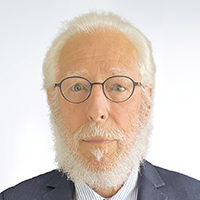
Paul F. Hoffman
2024 Kyoto Prize Laureates
Earth and Planetary Sciences, Astronomy and Astrophysics
/ Geologist
1941 -
Adjunct Professor, University of Victoria, Sturgis Hooper
Professor of Geology, Emeritus, Harvard University
A Ramble Through Geologic Time
2024
11 /11 Mon
13:00 - 16:10
Place:Kyoto International Conference Center
Capacity:1,500 persons (FCFS)
Admission Free
Based on geological evidence obtained over 50 years of extensive and precise field research in Arctic Canada and Africa, Paul F. Hoffman has accomplished landmark achievements regarding snowball Earth and plate tectonics in Earth’s early history that led to the present surface environment teeming with diverse life.
Through the accumulation of extensive and high-resolution field surveys for over 50 years, Paul F. Hoffman has made groundbreaking achievements regarding two significant factors, snowball Earth (global freezing) and plate tectonics in the deep past, which have formed the surface environment of the Earth, now teeming with diverse life.
By the late 1980s, several lines of evidence emerged that glaciers existed around the equatorial region approximately 600 million years ago. A possible explanation, the “snowball Earth” hypothesis, was proposed in 1992, which assumed that the Earth’s surface was fully covered with ice. However, this bizarre scenario appeared unrealistic to many researchers, thus academic circles paid it little attention. It seemed impossible for the Earth to return to warmer conditions following a fully frozen state. Such a long-term total freezing would eventually lead to total life extinction. Hoffman has conducted geological surveys in Namibia, Africa, since 1993, where he investigated similar glacial deposits of the same age, which are capped by abnormally thick carbonate strata (cap carbonates) that are essentially deposited in warm oceans and observed worldwide. His study on the cap carbonates by carbon isotope analysis revealed convincingly that biotic activities completely ceased immediately after glaciation. This result is concordant with the following snowball Earth hypothesis. The snowball Earth event was followed by rapid ice sheet melting under extremely warm conditions, due to a significant greenhouse effect of vast emission of volcanogenic CO2 gas. CO2-induced strong weathering of surface rocks provided abundant elements in the world seawater to form carbonates with carbon dioxide, i.e., depositing thick carbonate strata, whereas the organic activities remained dormant for some time. Hoffman further demonstrated that the snowball Earth condition occurred twice during the period of 720–640 million years ago. These drastic environmental changes on a global scale may have driven the rapid diversification of animals in the Cambrian period approximately 520 million years ago (Cambrian explosion).
Plate tectonics is a framework that describes relative motions (formation, horizontal movement, and subduction) of multiple tectonic plates, which form the rock crust that covers Earth’s surface. All geological phenomena currently observed, such as earthquakes, volcanic activity, and orogeny can be explained in a unified and consistent manner in this framework. Plate tectonics are solely found on Earth, thus it is likely the most critical factor that led to the habitable surface environment of the Earth. However, until the early 1980s, tectonic plate motions could only be traced back to approximately 500 million years ago and no further. Based on the extensive and detailed field survey in Arctic Canada, Hoffman demonstrated that the core of the present North American continent formed approximately two billion years ago by the multiple collisions and mergers of several major continental blocks. Furthermore, he revealed that the supercontinent cycles of repeated assemblies and breakups of smaller continental blocks took place 4–5 times from approximately 2.5 billion years ago to the present. Thus, he demonstrated that plate tectonics dates back to the first half of the 4.6 billion years of Earth’s history.
Throughout his lifetime geological research, Hoffman has shown that the essential factor for making the Earth habitable, as we know today, was the interaction between the solid Earth, atmosphere, hydrosphere, and even the biosphere. He is still actively continuing his research.
For these reasons, the Inamori Foundation is pleased to present the 2024 Kyoto Prize in Basic Sciences to Paul F. Hoffman.
Profile is at the time of the award.